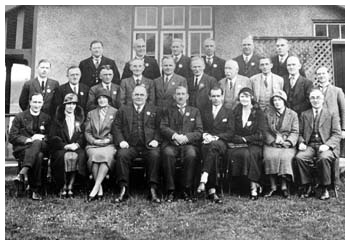
| Mountain Ash | ||||||||||||||||||||||||||||||||||||||||||||||||||||||||||||||||||||||||||||
 |
The development of Mountain Ash like so many other villages in South Wales was directly linked to the industrial development of the South Wales Valleys. Which was to eventually transform the village of Mountain Ash from a pastoral to a highly industrialised area. Mountain Ash, however, unlike Merthyr or Aberdare was to remain virtually untouched by the industrial revolution before 1850, having previously known nothing of the iron industry and coal extraction on a small scale. Left: The Aberdare Canal near Mountain Ash |
|||||||||||||||||||||||||||||||||||||||||||||||||||||||||||||||||||||||||||
The opening of the collieries in the mid nineteenth century led to the population of Mountain Ash increasing from 1,614 in 1841 to 11,463 in 1871. This rapid increase in population created a demand for both housing and public amenities. Houses were built and commercial, educational and religious buildings established. Some of the earliest streets were recorded on the1851 census and include Duffryn Street and Navigation Street. By 1859 there were 12 public houses, some of the earliest being the Bruce Arms, the Junction Inn and the New Inn. Many shops opened and goods and general provisions became easily St Margaret's obtainable and by 1920 Kelly's Trade Directory listed over 200 businesses within the village. In the image (right) D. Coleman advertises his general store located at 54 Commercial Street selling everything from boots to wines which was fairly common for the period. |
 |
|||||||||||||||||||||||||||||||||||||||||||||||||||||||||||||||||||||||||||
 |
Other significant buildings built during this early period of growth include the Town Hall (1904), two hospitals (1892 and 1894), a police station (1865) and Nixon's Workmen's Institute, Library and Public Hall (1899). The Pavillion was built in 1901 and was the venue for the Three Valleys Festival which started in 1930. Duffryn House was the home of Lord Aberdare.
Left: The Public Hall Mountain Ash |
|||||||||||||||||||||||||||||||||||||||||||||||||||||||||||||||||||||||||||
Once the ancestral home of Henry Austin Bruce, the first Lord Aberdare, his ancestors having purchased the Duffryn Estate in 1747. In 1926 the house was purchased by the Glamorgan Education Authority and became the County Grammar School, later part of Mountain Ash Upper Comprehensive School. The house was used for lessons up until 1983, when it was found to be unsafe and eventually demolished. Right: Duffryn House |
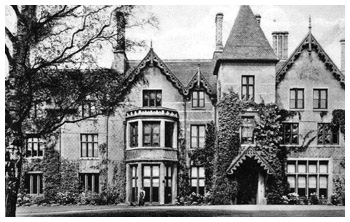 |
|||||||||||||||||||||||||||||||||||||||||||||||||||||||||||||||||||||||||||
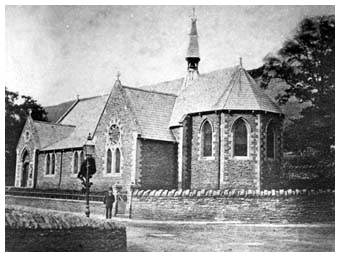 |
Many religious denominations established buildings within Mountain Ash, among the first being the Baptists who built Rhos Chapel in 1855 and Nazareth Chapel in 1866. The church of St Margaret's was consecrated as the central church for the new parish of Mountain Ash on the 14 August 1862, and the Roman Catholic Church was built in 1899.
Left: St Margaret's Church |
|||||||||||||||||||||||||||||||||||||||||||||||||||||||||||||||||||||||||||
| Nos Galan | ||||||||||||||||||||||||||||||||||||||||||||||||||||||||||||||||||||||||||||
| Nos Galan, the Welsh for New Year's Eve, gave its name to the races, which began in 1958. The first year consisting of a 100 yards sprint in Oxford Street and a 4-mile race, with the competitors 'running into' the New Year. With Peter Radford winning the 100 yards race and Stan Eldon the 4-mile race. The event caught the imagination of both runners, drawn by the unique nature of the race and the hospitality of the people, and the media drawn to the idea of Olympic runners running through the streets of a mining town at midnight on New Years Eve. | ||||||||||||||||||||||||||||||||||||||||||||||||||||||||||||||||||||||||||||
At its peak in the 1960's the event attracted over a thousand runners and was covered by BBC Grandstand. Peter Gabbett winning the 100 yd. race
|
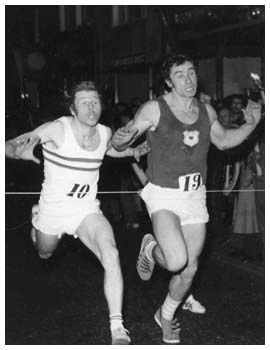 |
|||||||||||||||||||||||||||||||||||||||||||||||||||||||||||||||||||||||||||
|
||||||||||||||||||||||||||||||||||||||||||||||||||||||||||||||||||||||||||||
| Past Mystery Runners at the grave of Guto Nyth Bran in Llanwonno Church L to R: Berwyn Price (1973), Kirsty Wade (1986), Derek Ibbotson (1960), Ron Jones (1967), John Merriman (1961), Stan Eldon (1964) | 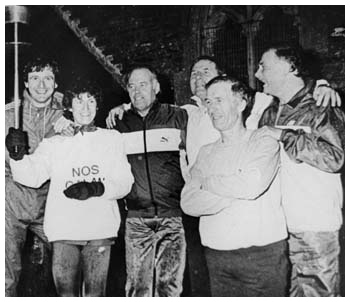 |
|||||||||||||||||||||||||||||||||||||||||||||||||||||||||||||||||||||||||||
Despite their popularity the races were halted in 1973 due to concerns expressed by the police regarding the undue delay to traffic.
The programme (right) is from the Third Nos Galan Race in 1960 when the event was at its height and the streets of Mountain Ash were packed with people until the early hours of New Years Day
|
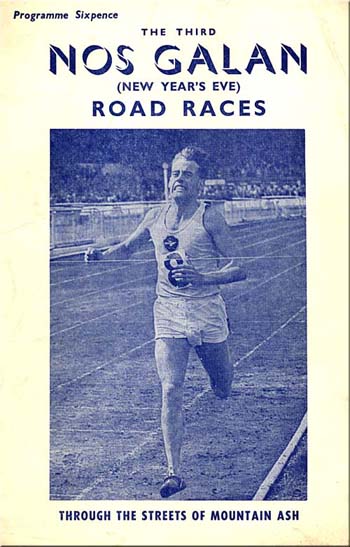 |
|||||||||||||||||||||||||||||||||||||||||||||||||||||||||||||||||||||||||||
| Guto Nyth Bran | ||||||||||||||||||||||||||||||||||||||||||||||||||||||||||||||||||||||||||||
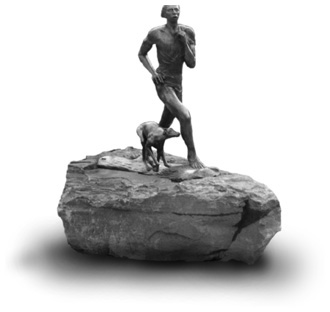 |
Griffith Morgan, or Guto Nyth Bran as he was better known took his name from Nyth Bran Farm where he lived, near Porth in the Rhondda Valley. He was an exceptional runner and many stories are told of his ability. How he could run to Pontypridd and back, some seven miles, before the kettle boiled and how he could chase down hares. Guto was famous for winning many races and it was said that his best friend Sian the Shop had become a 'wealthy women' by 'betting on his legs'. His final race at the age of 37 was against an Englishman named Prince over a 12-mile course from Newport to Bedwas Church. Guto won easily and crossed the line so full of running, that Sian the Shop rushed forward to congratulate him, slapping him heavily on the back as she did. The slaps proved to much for Guto after running such a hard race and his heart jumped out of place,and he fell to the ground dead. His body was carried amongst scenes of great grief to St Gwynno's Church, were his grave lies today. The statue of Griffith Morgan - Better known as "Guto Nyth Bran" located in Oxford Street, Mountain Ash |
|||||||||||||||||||||||||||||||||||||||||||||||||||||||||||||||||||||||||||
| Mountain Ash Coal Industry | ||||||||||||||||||||||||||||||||||||||||||||||||||||||||||||||||||||||||||||
| Mountain Ash unlike other districts further to the north did not produce coal in significant quantities until 1850. For although a number of small mines had opened in the district prior to this date, these had failed and therefore had no great influence upon the surrounding area. It was the collieries with deep shafts, mining the 4ft seam that were to become the nuclei around which the village grew. | ||||||||||||||||||||||||||||||||||||||||||||||||||||||||||||||||||||||||||||
| Deep Duffryn Colliery - Sunk by David Williams in 1850, this was the first colliery of any significance to be established in the lower end of the Cynon Valley. The sinking proved to be a hazardous and costly operation due to the soft sandy nature of the soil, with it taking five years to reach the four foot seam at a depth of 849 ft. The colliery was sold in 1856 to John Nixon who installed a new ventilator and winding engines, improving the working conditions at the colliery and raising the level of coal production. The colliery was owned and worked by Nixons Navigation Company until 1930 when it was merged with the Welsh Associated Collieries Limited. In 1935 the colliery was purchased by Powell Duffryn Associated Collieries, who retained ownership of the colliery until the nationalisation of the coal industry in 1947. Deep Duffryn Colliery eventually became uneconomical and was closed by the National Coal Board in 1979. | 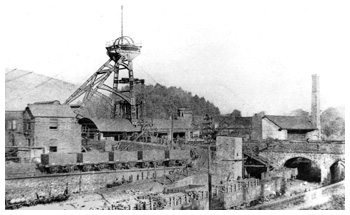 |
|||||||||||||||||||||||||||||||||||||||||||||||||||||||||||||||||||||||||||
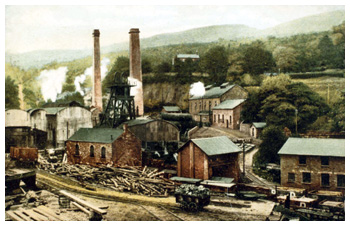 |
Lower Duffryn Colliery - Also known as Cwmpennar Pit. Sinking of this colliery commenced in 1850 by Thomas Powell and Sons, with coal being first raised in 1854. The colliery was sold in 1864 to the Powell Duffryn Steam Coal Company who owned the colliery until its closure in 1927. | |||||||||||||||||||||||||||||||||||||||||||||||||||||||||||||||||||||||||||
| Nixon's Navigation Colliery - Sunk by John Nixon, work began on the colliery in 1855. Coal production did not however commence until 1960 and the venture almost brought ruin upon him. When sunk it was said to be the deepest colliery in Wales, reaching a depth of 1350 feet. By 1930 the colliery had been acquired by the Welsh Associated Collieries, who retained ownership until 1935. At the time of its closure, in 1940, the colliery was owned by Powell Duffryn Associated Collieries. | 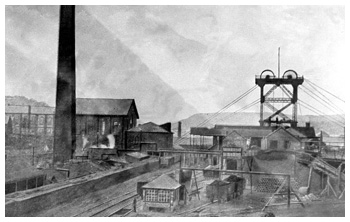 |
|||||||||||||||||||||||||||||||||||||||||||||||||||||||||||||||||||||||||||
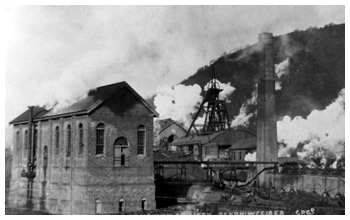 |
Cwmcynon Colliery - Following his successful venture with the Navigation Colliery, John Nixon continued to sink collieries in the Mountain Ash area. One of which was the Cwmcynon Colliery sunk in 1889 by the Nixon Navigation Co. Ltd. This colliery, situated to the south of the town, employed more than a 1,000 men in 1911 and was eventually linked up from below ground with both the Navigation and Deep Duffryn Collieries. The colliery changed hands a number of times prior to the nationalisation of the coal industry in 1947, being owned by the Llewellyn-Nixon Collieries Co. Ltd (1929), the Welsh Associated Collieries Ltd. (1930) and the Powell Duffryn Associated Collieries (1935). Cwmcynon Colliery was closed by the National Coal Board in 1949. | |||||||||||||||||||||||||||||||||||||||||||||||||||||||||||||||||||||||||||
| The Three Valleys Festival | ||||||||||||||||||||||||||||||||||||||||||||||||||||||||||||||||||||||||||||
Dr Malcolm Sargent at the Three Valleys Festival, 1932 |
||||||||||||||||||||||||||||||||||||||||||||||||||||||||||||||||||||||||||||
| It was Sir Walford Davies who had the idea of bringing together the choirs of the Merthyr, Cynon and Rhondda Valleys to create a festival of choral and orchestral music. He wanted to do something for the unemployed of the valleys and hoped to create a people's festival. As reflected by the low admission prices, the big capacity of the venue, and the provision of late trains and cheap fares. The first festival, a weeklong event, was held at the Mountain Ash Pavilion during May of 1930. It was to retain its association with the Mountain Ash Pavilion throughout its life although the format was changed when it became a three-day festival in 1932. The festival was a tremendous success, attracting some of the most famous singers and conductors known to the music world. The original festival featured three guest conductors, these being Sir Henry J. Wood, Dr. Malcolm Sargent and Dr. W. Gillies Whittaker. In the following years the festival was to become associated with the conductor Dr. Malcolm Sargent who was guest conductor on no less than seven times, only missing the remaining years due to illness. |
Officials and Executive Committee of the Three Valleys Festival, 1932 |
|||||||||||||||||||||||||||||||||||||||||||||||||||||||||||||||||||||||||||
The Festival was successfully held at the Mountain Ash Pavilion until 1939 when it was disrupted by the war. During the war years Regional Festivals were held at various centres in South Wales, helping to keep the flag flying and taking the festival spirit to other centres. The festival did return to the Mountain Ash Pavilion in 1947 following a seven-year absence but this was to be the last year that the festival was held at Mountain Ash |
||||||||||||||||||||||||||||||||||||||||||||||||||||||||||||||||||||||||||||

